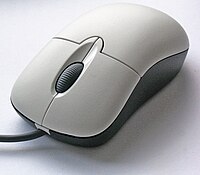
Photo from wikipedia
The purpose of this study is to investigate the effects of different cursor click modalities in an alternative computer access device using accelerometry from head tilt to control cursor movement.… Click to show full abstract
The purpose of this study is to investigate the effects of different cursor click modalities in an alternative computer access device using accelerometry from head tilt to control cursor movement. Eighteen healthy adults performed a target acquisition task using the device with five different cursor click modalities, while maintaining cursor movement control via accelerometry. Three dwell-based click modalities with dwell times of 0.5 s, 1.0 s, and 1.5 s were tested. Two surface electromyography-based click modalities - with the sensor placed next to the eye for a blink and above the eyebrow for a brow raise - were tested. Performance was evaluated using metrics of target selection accuracy, path efficiency, target selection time, and user effort. Surface electromyography-based click modalities were as fast as the shortest dwell time and as accurate as the longest dwell time, and also minimized user effort. Three of the four performance metrics were not affected by sensor location. Future studies will investigate if these results are similar in individuals with neuromuscular disorders.
Journal Title: IEEE Transactions on Neural Systems and Rehabilitation Engineering
Year Published: 2020
Link to full text (if available)
Share on Social Media: Sign Up to like & get
recommendations!